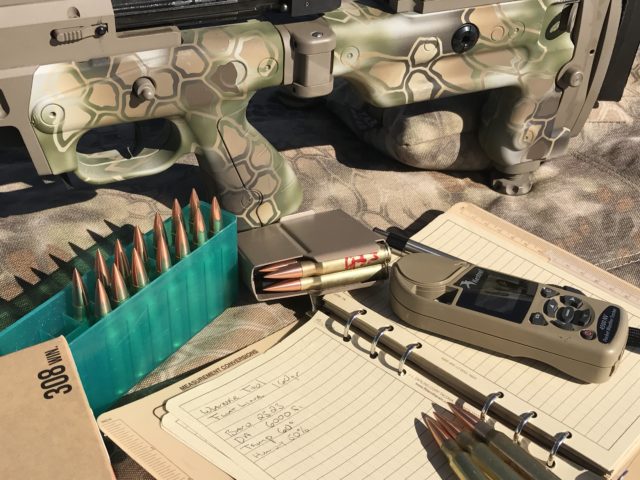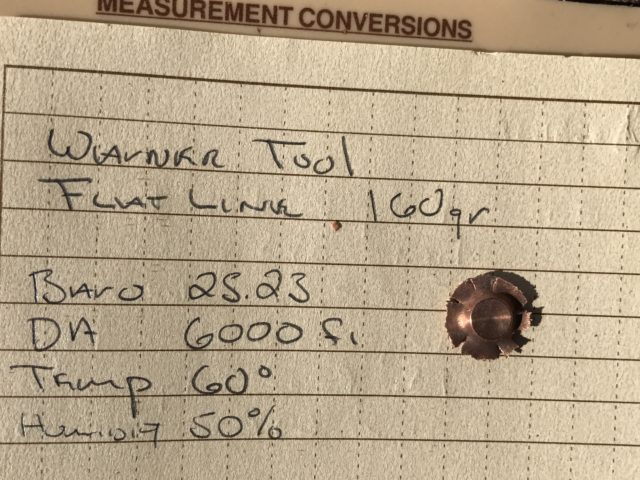Recently I reviewed the Warner Tool Flat Line 180gr Solids and soon after a lot of questions came my way. Because I took a bit of a different direction with these bullets, by using a short-barreled 308 and not something like a 300WM, guys wanted to adapt my results to a set of tactical scenarios. The 180s were being single fed, they were loaded very long, but the results were hard to dispute. They were fantastic, coming in with a BC in the .7s out of a 308.
Rather than recommend a way to adapt these bullets, Dan Warner quickly sent me a new bullet designed explicitly for mag length, 308 rifles that would cross into the tactical lane versus the single fed F Class context one might use the 180s.
The questions ranged from mag length loading to gas gun shooting, even the use of barrels much shorter than the 20” one I tested the 180s with. For me, it comes down to the “Right Tool” for the job. The 180s were clearly not the right tool, which is why we have such a wide variety of bullets to choose from.
With 100 of the new 160s in my hand, I was ready to try them out and see what results these would give me. Before I start, I want to put my results in context: First off, I am in Colorado, my range elevation is 4600ft above sea level. These conditions make my average Density Altitude 6500ft. Desirable results which will need to be translated to shooting at sea level.
I am using an excellent Bartlein Barrel on my AX rifle. My Bartlein barrels will run faster than your average factory barrel. The twist rate on the majority of my 308 rifles is 1-10. The Accuracy International AX is the same; it’s a 1-10 twist. Don’t confuse it with an older 1-12 twist AI 308. That said, the 160s should work very well in everything from a 1-12 to the faster barrels out there.
My loads are not hot but could be in your rifle, so take caution. The Accuracy International AX is a combat sniper rifle. It’s a bit more bulletproof than your average 700. Use caution if you try repeating my results. I had zero issues with bolt lift, or crated primers, these loads worked great in my rifle. My AX308 is not yours, do your reloading homework.
Now to the meat and potatoes of the matter, the 160s on the range out to distance.
Load development

I went through a couple of rounds of load development with these Flat Line 160s. First, I started out with Varget, but for whatever reason, I had no muzzle velocity out of this powder. 45grs of Varget gave me excellent accuracy, but my muzzle velocity was only about 2465fps. I was looking for speed with this bullet. I suspect my jug of Varget was compromised, so I stopped even trying with it and immediately switched to different powders. I used a 2000MR load as noted in my 180 FL Review and finally settled on H4895. It was about 50fps faster.
My goal, aside from speed, was to find an accurate load that was mag length. I had a personal request for 2.830,” so that is what I focused on — speed and accuracy from an OAL that met this specific requirement. I could have and would recommend working up using the OCW method and then fine-tune your seating depth. I settled on 44.8gr of H4895.
2.830” and 44.8grs of H4895 was used in the video and for this review. All results are based on this out of my 20” AX rifle with 1-10 twist. Before starting this process, Dan also recommended 4895 at 2.800”, so this powder appears to be working for more people than just me. It balances speed and accuracy.
Solids are designed to be pushed hard and fast.
Having worked with a variety of solids over the years, I can tell you, what you might do for a jacketed bullet can be pushed beyond with a solid. They like a fast twist, and they want speed. This combination is what will give you the superhuman results we see.
Solids vs. Jacketed Bullets There is an unwritten rule of thumb that says you don’t want to mix solid bullets and jacketed bullets down the same barrel. You’re not supposed to shoot them together without a complete cleaning the barrel. This is not the case with the Warner Tool Flat Line Bullets. Before starting any shooting, I ran jacketed bullets through the barrel. Only once between shooting the 180s and the 160s, with at least 500 jacketed bullets between, was the barrel cleaned. These results were recorded having mixed the two. I did re-zero the scope at 100 yards, but before doing so, I shot a group of Prime 175s.
On the Range

Once the load was established and my criteria met, I loaded up 50 rounds and headed to the range. My goal was to dope my rifle from 100 to 1500 yards.
Before hitting the range, I used TRASOL to establish some “TRY DOPE” to get me in the ballpark. Understand information with a new bullet is very limited, and attempting to shoot them out to distance can be a challenge. So taking the details from my load development, I inserted the basics into TRASOL.
The recommended BC was .57, with a muzzle velocity of 2850fps.
Conditions for the Day
Barometric Pressure (Absolute) 25.17
Temperature: 67 degrees
Humidity: 25%
Density Altitude: 6500ft
Wind 6MPH – 12MPH (over the course of the day)
My actual data recorded was not always perfectly centered, so my video had to be reviewed and adjusted. But here was the dope recorded at the distances shot:
400 yards – 1.5 mils
600 yards – 3.0 mils .2 mils right wind
800 yards – 5.0 mils .5 mils right wind
1125 yards – 8.8 mils 1.5 mils right
1250 yards – 10.9 mils 2 mils right
1440 yards – 13.8 mils 2.2 mils right
1500 yards – 15.5 mils 2 mils right
During these shots, I fired 25 rounds across the LabRadar and recorded:
Average Muzzle Velocity: 2851fps
SD 10.5fps
Taking this data and reviewing the video, I was able to update my TRASOL Data and established a corrected Track using the BC .585 for the AI AX rifle. The G7 BC hovers around .29 for my results. Understand my results may vary from yours; however, I am very close to the .57 BC that Warner Tool gave me.
Out of 20” 308, these results were outstanding. Now let me elaborate a bit on this. The shots were predictable, even with the varying wind I had this day. The hardest part is to keep up with the wind changes, especially when you are out shooting alone acting as your own spotter. I have to look at both the windage and my elevation to dope the rifle as close to center with the limited number of rounds. Calculating the data, I am supersonic until 1650 yards, and at 1500 yard, my MV is very close to 1200fps. This allows me to see results, make a change, and have that change matter. You can see it in the video on the 1125 yard target. My first shot hit the hostage flopper at the top of the target. I made a .2 correctly and smacked the chest flopper dead center. I followed this up with two more hits.
If you want to extend the reach of your rifle or increase performance thanks to a super high BC at speeds that will rivals the 6.5s out there, this is your bullet. Loaded to mag length, the Warner Tool Flat Line 160s are impressive on every level. Lastly, because they are not super pointy like the 180s, these bullets feed perfect and will not be damaged if you run them in a gas gun. It’s a different design than the 180s that will work for the tactical shooter.
Cost vs. Performance
Based on the review of the 180s, the number one piece of negative feedback I have received revolves around the price. I get it; solids are not cheap. But neither is shooting a precision rifle. We are not shooting $400 handguns, or $1200 AR15s. We are using $5000+ rifles, and $2500+ scopes, hell I can easily demonstrate this with a $7200 AX308, using my $6800 Hensoldt 3-26x, the question is, how much more performance do you want? Performance costs money. We get that ahead of time. Ask any guy building a race car.
The Warner Tool Flat Line 160s are the same price as their 155s. They are just over a $1 a piece at $65 per 50 bullets. $600 for 500.
If your budget is limited, these are not the right tool for the job. If you are comfortable shooting a $20 box of Privi 168s, these are not for you. Enjoy your lane, however, if you want to squeeze some performance out of your 308 when the rest of the crowd is using a 6.5, or 6mm, here is your equalizer. Pick your race, and run it hard. It’s not plinking ammo, nor should it be looked at as something you shoot every day.
We have competitions out there that are entirely Open Class, 308s are competing with everything else, where the speed limit is 3200fps. How do the 308 shooters match the ballistics out of a magazine length bullet? Warner Tool Flat Line Projectiles. For those who might want to go the F Class route with either these or the 180s, understand F Class only limits the use of solids in the largest of International Competitions. Domestic F-Class matches have no such rule unless it is a range specific rule against solids. As far as PRS events, have at it, I have never seen a rule limiting solids and I can tell you there is no damage to the steel.
If you shoot the 308 class, have a semi-stock rifle or are in the production class, upgrade the bullet and leave the rifle alone. You can shoot any ammo you want and still be within the rules of the production class. When you need that little extra, turn your bullet up to 11.
If you were slick, you could probably load some, record the offset from your normal load and put that data into a ballistic solver. When the targets are bit farther, you can switch bullets. Using 7 Mils instead of 10.5 mils might help keep the points on the board. The possibilities are endless without spending a ton of extra money. Today you get these field matches that throw in a 1-mile target, having a handful of Flat Line bullets ready to go might just get you that hit and solidify your competition weekend fame using your 308.
I had four rounds left to shoot at 1500 yards. In the switching winds using a 1.5 mil holdover because the scope topped out, I managed a 3rd round hit. My try dope was .5 mils off at 1500; the performance makes the difference when you can predictability adjust. It’s the game-changer at extended distances.
Predictability is essential.
I see the benefit, but I also understand precision rifle shooting is an expensive sport.
I want to thank Dan Warner, Josh Kunz for including me in this. It was fun; it was impressive with both the 180s and 160s and it turned my 20” 308 AI AX into a 26” 6.5. That in itself is amazing.
Better barrels, bullets, and powders are changing the rules from what your Dad did in 1978. Old standards no longer apply on so many levels.

